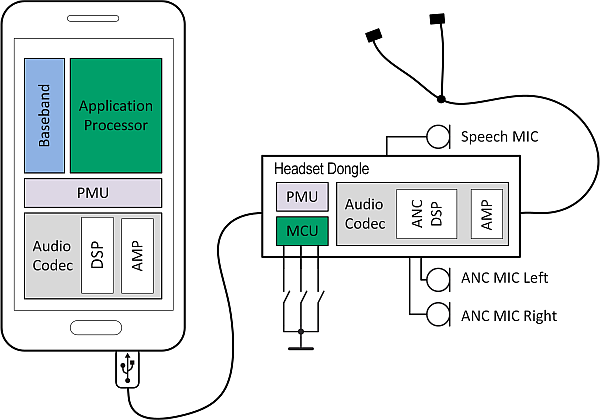The 3.5mm phone jack is a well-established standard in the audio industry and continues to get strong support from users in the market. Originally invented in the 19th century for telephone switch boards, it made its way into mobile phones, tablets, and personal computers to connect audio and communication headsets for phone calls or simply for listening to music. While the phone jack has a rather long evolutionary history, the functionality that the 3.5mm four-pole accessory device provides to its end customers is rather limited.
A simplified block diagram of an existing 3.5mm audio jack implementation is shown in Figure 1. The diagram shows the standard 3.5mm audio jack that is connected to the audio codec inside the mobile phone. To support speech transmission for phone calls there is the MIC and BUT input, where the fourth pole of the audio jack is connected. This signal line has an analog microphone connected, and in parallel, one to three push buttons each with a series resistor.
If a button is pressed, the serial resistor defines, with the bias resistor RBIAS inside the phone, a voltage drop that can be measured by the button detection ADC to accept a phone call or simply change music playback volume. If no button is pressed, the microphone is active and the captured speech signal is digitized by the speech ADC inside the audio codec and then fed into the baseband.
The architecture shown in Figure 1 hasn’t changed during the last couple of years, despite how rapidly mobile phones are evolving. Based on the possibilities mobile phones offer nowadays in terms of computation power, the functionality that 3.5mm audio jack accessories can provide is rather limited. One reason for this might be that headsets are very cost-optimized and need to be compliant with each other. Thus, there is a continuous pull from the market to enhance the functionality of the 3.5mm audio jack while keeping the cost at a minimum.
One particular application requested by many vendors is the support of active noise cancellation (ANC) without the need of a battery inside the accessory. This function was only possible with a battery inside the accessory and an analog or digital ANC device inside the headset, as shown in Figure 3. An alternative solution, which eliminates the need for the battery, makes use of the USB interface to get power out of the mobile phone (Figure 2).
Read more: Data-rich 3.5mm jack vies with USB-C for headsets

